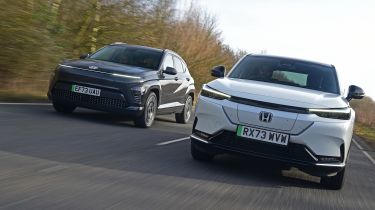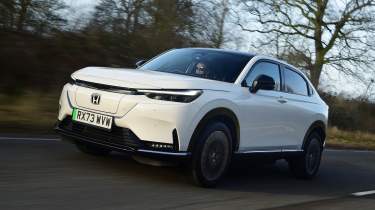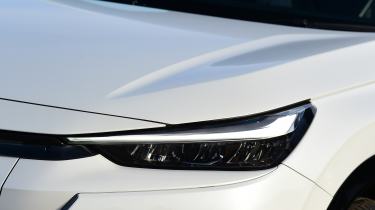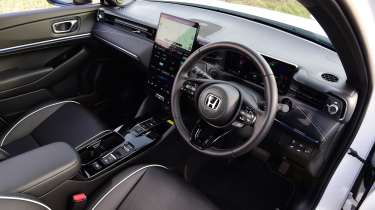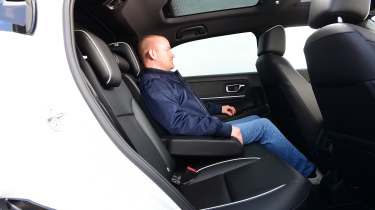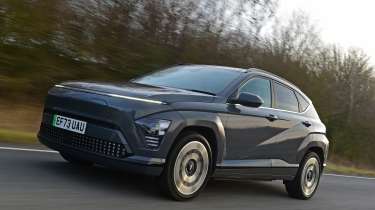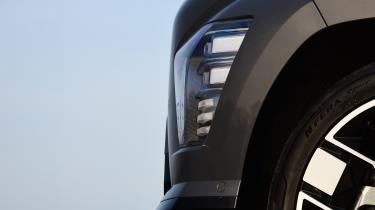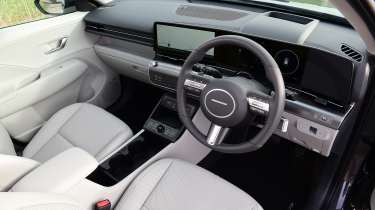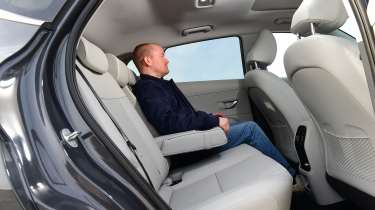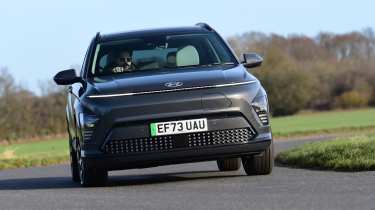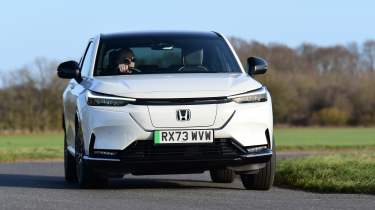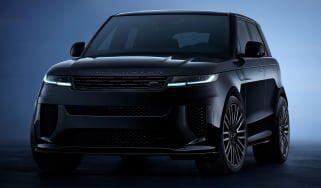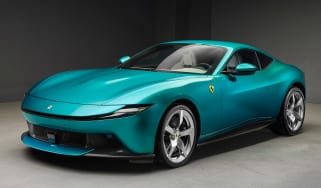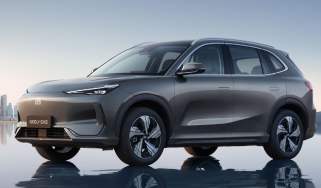Honda e:Ny1 vs Hyundai Kona Electric 2024 twin test: an electric SUV duel
Competitive finance offers mean the Honda e:Ny1 is more attractive than ever. Is it more tempting than a Hyundai Kona?
While some car manufacturers have been busily releasing a wide range of electric cars, others have been a little quieter on the EV front. One example of the latter is Honda. Its first attempt was the Honda e, a sophisticated city car with fabulous design, fascinating technology and the sort of slick engineering that we almost take for granted from the Japanese brand. However, it was ultimately hampered by a high price.
Now comes Honda’s second attempt. It’s called the e:Ny1, and Honda hopes it’ll find more homes than the e, because it competes in the much more popular small-crossover segment.
But there’s tough competition in this class, and no rival will give it a sterner test than the Hyundai Kona Electric. Our 2023 Car of the Year is the EV that every other rival in this class must beat; even if the Honda runs it close, it will be a fine attempt, but will Honda’s second stab at electrification right the wrongs of the previous model?
| Honda e:Ny1 68.8kWh 150kW Advance | Hyundai Kona Electric Long Range Ultimate | |
| Price: | £47,195 | £43,095 |
| Powertrain: | 1x e-motor, 68.8kWh battery, 201bhp, front-wheel drive | 1x e-motor, 65.4kWh battery, 215bhp, front-wheel drive |
| 0-62mph: | 7.8 seconds | 7.8 seconds |
| Test efficiency: | 2.4mi/kWh | 3.2mi/kWh |
| Max charging rate: | 78kW | 101kW |
| 10-80% | 45 minutes | 43 minutes |
Honda e:Ny1
It’s fair to say that our initial impressions of the e:Ny1 were lukewarm, and a large influence on our three-star rating was the whopping £47,195 price tag of top-spec Advance trim. That’s the car we’re testing here, but some very punchy finance deals have made the Honda much more tempting. Is that enough to turn things around?
Tech highlights
While the car’s name is all new, the e:Ny1 looks a little familiar. That’s because, for Honda’s second attempt at an electric vehicle, it hasn’t quite started from scratch. Instead, the e:N Architecture F that is suitable for a range of front-wheel-drive electric vehicles is a heavily adapted version of an internal-combustion platform. The changes have enabled Honda to fit a 68.8kWh battery under the floor and house a single electric motor between the front wheels; the motor produces a healthy 201bhp and 310Nm of torque.
Used - available now

2023 Peugeot
3008
18,185 milesAutomaticPetrol1.6L
Cash £21,600
2021 BMW
X3
61,267 milesAutomaticDiesel2.0L
Cash £24,100
2022 Toyota
Corolla
19,179 milesAutomaticPetrol1.8L
Cash £14,400
2022 Vauxhall
Corsa
16,883 milesManualPetrol1.2L
Cash £11,800Cosmetically, the e:Ny1 shares plenty with the HR-V crossover, from the angular headlights and sloping roofline towards the back end and rear doors with handles integrated into the C-pillars. The two SUVs are virtually identical when it comes to width, height and wheelbase, with the EV stretching a negligible 47mm longer than the hybrid model that gave the Kona Hybrid a run for its money earlier this year.
Safety: Euro NCAP hasn’t yet tested the e:Ny1, but the HR-V scored four stars back in 2022, as did the larger ZR-V in 2023, while the Jazz and Civic, which share tech with the e:Ny1, scored five stars when they were tested in 2020 and 2022 respectively.
Most safety kit is standard on even the base Elegance trim, but the Advance also benefits from side parking sensors to further reduce the risk of low-speed scrapes.
On the road
There are strong points to the e:Ny1’s driving experience, but they’re eclipsed by some much larger oversights in terms of refinement and electric-motor calibration.
Around town: Typical of many Hondas, the basic controls are beautifully judged. The steering is fairly light but precise, while the brake pedal is well weighted and offers a seamless transition between deceleration by regenerative braking and the physical action of the pads squeezing the discs. The regen can be adjusted via paddles on the steering wheel, but even in its strongest setting, it’s very weak.
A & B-roads: At 7.7 seconds, the e:Ny1’s 0-62mph time is spot on for this segment, but the way it deploys that power is much less impressive. In all but warm, bone-dry conditions, it’s too easy to light up the front tyres with wheelspin – and it’s worse if there’s even a small amount of steering lock applied.
At low speeds that means if you’re just the slightest bit clumsy with your inputs, you’ll seem a little obnoxious when pulling out of a junction. But on a twisty road, if you’re too keen to jump on the throttle when exiting a corner, you can risk the front wheels ploughing into dramatic understeer.
With the most delicate right foot, the Honda’s chassis reveals itself to have a neutral balance with minimal body roll, though.
Motorway: The 18-inch wheels of our test car caused quite a lot of fidget at all speeds. More surprising is the noise from the motor, which emits a noticeable whine that is still audible at 70mph. On the overwhelming majority of rivals, any high-pitched noises that can be heard fade out at much lower speeds.
Ownership
Inside, the e:Ny1 greets you with a vast central touchscreen. We’ll go into further detail in the infotainment section, but most of the car’s secondary functions, including the climate controls, are located on that display, which isn’t as intuitive to use on the move as a set of physical controls. It’s a shame, because its hybrid cousin, the HR-V, still has dials and buttons, and they feel expensive and well damped, so an element of tactility that Honda can do so well is lost.
This test took place during a week of the kind of very cold weather that takes the edge off an EV’s efficiency. But while the relatively low numbers in this test are something of a worst-case scenario, the Honda’s 2.4mi/kWh is still some way behind the class average. At those figures, the e:Ny1 will only be able to cover 165 miles between charges.
Like the Honda, the Hyundai was affected by the cold weather. A useful point of reference is the Kia Niro EV that took part in a recent test against the Volkswagen ID.3 and Jeep Avenger. Despite it sharing similar mechanical tech, the Kona averaged 3.2mi/kWh compared with the Kia’s 3.9mi/kWh in fairer conditions.
A standard-fit heat pump helped to mitigate any efficiency drop-off in the Kona. You’d only lose five miles of predicted range from a full charge if you turned the heater on, but if you want to stay warm in the Honda, things get worse. Here, it slashed the overall range from an indicated range of 181 miles at 100 per cent to just 134 miles.
Storage: Honda has furnished the e:Ny1’s cabin with plenty of cubby space. The glovebox is large, the front occupants get two deep cup-holders and the wireless smartphone charging space is roomy. The bin beneath the central front armrest is ideal for hiding away smaller valuables if necessary. The only minor gripe is with the door bins; the front ones are small and there aren’t any in the back.
Practicality
Interior space is something of a mixed bag for the Honda, with excellent legroom compromised by below-average headroom and boot space.
Rear space: Back-seat kneeroom is one of the most impressive aspects of the e:Ny1’s interior. Against the tape measure it’s almost identical to a Volkswagen Touareg, which makes it easier to forgive the fact that the seat base is set quite low relative to the floor.
The seats are soft and comfortable and are more supportive than the Kona’s, but the sloping roofline means that headroom is a little tight for a car in this class.
Boot: Legroom has come at the expense of boot space, because a 344-litre volume is towards the lower end the class. The load space is a little irregular; the floor tucks in around the inner wheelarches and at 703mm, the load lip is high.
What to buy?
Which version we’d choose…
- Powertrains: Honda is currently offering the e:Ny1 with a single all-electric powertrain.
- Trim: There are two trim levels to choose from. Elegance kicks off the range at £44,995, and still has a fairly strong roster of standard equipment; wireless smartphone charging, heated front seats, keyless entry and go, front and rear parking sensors and a reversing camera are all included. Advance adds a panoramic sunroof, a powered tailgate and a heated steering wheel among other features, and increases the overall price to £47,195.
- Our choice: We’d go for the entry-level Elegance trim to keep the monthly costs low.
Hyundai Kona
We’re testing the Kona here in top-spec Ultimate Long Range guise. It’s priced from £43,095, which is high when compared with the entry-level models, but is still significantly cheaper than the Honda before any financial incentives are factored in.
Tech highlights
For the latest-generation Kona Electric, Hyundai listened to feedback from owners of the previous version. With many desiring more practicality, the new model has grown larger than its predecessor.
There were very few complaints about the powertrain, which is why the motor and battery specs haven’t altered significantly from the first-generation model. At 215bhp, it’s 14bhp up on the Honda, but its 255Nm torque maximum is 55Nm down on the e:Ny1. The 65.4kWh battery is marginally smaller than its rival’s, too, but despite this – and a marginally higher kerbweight – the Kona’s official WLTP range is 282 miles, beating the Honda by 26 miles.
One key useful piece of tech that sets the Kona apart from the e:Ny1 is its standard-fit heat pump. This is frequently only an option on rivals, but here it means that the Kona is able to condition its battery in colder weather, so that the effects of sub-zero temperatures – and in particular using the cabin heater – are reduced.
Safety: The Kona scored four stars when Euro NCAP assessed the latest model in 2023. Its lowest-scoring category was the Safety Assist section, where it achieved a 60 per cent mark.
While NCAP rated its lane-keep assist highly, we found on test that it was overly intrusive, so we tended to switch it off before driving. The driver- attention warning system is also a little over-zealous when it comes to chiming alerts, too.
On the road
From a driving point of view, the Kona scores strongly in all the areas that matter for a practical family crossover. It’s easy to drive at low speeds, and comfortable, relaxing and secure everywhere else.
Around town: The Hyundai is a little easier to drive smoothly than the Honda because the throttle has a softer initial response. The steering is light, and the brake regeneration has four strength levels, from complete coasting to strong deceleration; the ability to change these levels on the fly thanks to steering column-mounted paddles is a great feature. An adaptive mode adjusts the regen based on traffic and road conditions, but like most systems of this type, we found it unpredictable, so preferred to turn it off.
A & B-roads: On more open roads, the Kona proves itself to have a softer, more forgiving ride than the Honda. Its steering is also less responsive and it feels a little slower to turn into a corner, so it’s predictable – if not particularly fun – along a twisty road. However, the Hyundai has more grip than its rival, so it’s the more reassuring car to drive, regardless of the road conditions.
Get through the throttle pedal’s long travel and there’s nothing to separate the performance of this pair. Officially, the Kona’s 7.8-second 0-62mph time is just 0.1 seconds shy of the e:Ny1’s, and it still feels more than lively enough for a car of this type.
Motorway: That steady handling pays dividends at higher speeds, where the Kona feels stable and secure. It’s also slightly more peaceful than the e:Ny1 at a cruise. Two factors contribute to this; first, the Kona’s motor is much quieter (it’s rarely audible even under hard acceleration), and second, there’s less wind noise at higher speeds.
Ownership
Compared with the Honda’s quite snug-feeling cabin, the Hyundai is more airy and open. This is partly due to the large, open space between the front seats, but it’s also thanks to the landscape arrangement of its touchscreen; it doesn’t poke out above the dash like the unit in the e:Ny1, so the Kona presents a slightly clearer view of the road ahead.
There’s plenty of adjustment in the seats, but some testers found that the headrest poked out a little too far from the seat back, causing a slightly hunched driving position. Interior quality is fine for a car in this segment, although the Honda holds a slight edge when it comes to perceived quality.
All Hyundais come with a five-year, unlimited- mileage warranty. The Honda can match that, though, and it also comes with the added benefit of five years’ roadside assistance (the Kona only has 12 months of cover) and free servicing.
There’s nothing to separate this pair from a customer satisfaction point of view. In our 2023 Driver Power survey, Honda was ranked 18th out of the 32 brands covered, while Hyundai just squeaked ahead into 17th. Only 15 per cent of Honda owners who responded had reported a fault of any kind within the first year of ownership, ranking it among the most reliable brands surveyed. At 21 per cent, Hyundai still ranked a strong 10th best in the reliability stakes.
Storage: Just below the main section of the dashboard, the Kona has a neat cubby to house a smartphone while it wirelessly charges, plus there’s a small shelf on the passenger side of the dash that’s useful for holding loose items.
Between the seats, there’s another deep bin with pop-out cup-holders, but there isn’t too much covered space available beneath the central armrest. The door bins are very generous up front, but those in the back only have space to carry a small bottle.
Practicality
Practicality is a Kona strong point, with enough interior space to match cars from the class above.
Rear space: Despite its fairly modest exterior dimensions, the Kona is impressively spacious inside. Indeed, it’s almost a match for its bigger brother, the Tucson, in all but elbow room. The seats aren’t quite as comfortable as the Honda’s, but fitting a child seat is much easier. Here, the Isofix mounts poke out from the seat bases far enough, so that they’re easy to locate, but in the Honda they’re buried deep and are very hard to reach.
Boot: At 466 litres, the Kona’s boot is larger than the Honda’s and one of the best among similarly sized EVs. The opening is wide, the load lip is level with the boot floor, and the space has next to no wheelarch intrusion. There’s also a useful 27-litre front boot that’s ideal for charge cables.
What to buy?
Which version we’d choose…
- Powertrains: The Kona line-up kicks off with the Standard Range, which gets a 48kWh battery – good for a WLTP distance of 234 miles – and a 154bhp motor. The Long Range bumps up the battery to 65kWh and power to 215bhp. Like for like, it costs £3,600 more.
- Trim: The Standard Range is only available in the base Advance trim, while the Long Range is available in Advance, N Line, N Line S and Ultimate versions. All models get cruise control, parking sensors and a heat pump. N Line S and Ultimate models cost the same, but the former has sportier styling.
- Our choice: The Advance trim paired with the Long Range battery is an ideal all-rounder.
Results
Which car comes out on top?
Winner: Hyundai Kona
The Hyundai Kona remains the benchmark in this class in so many ways. It manages to mix a wide spread of appealing qualities – from competitive performance and efficiency, to one of the most spacious cabins in the segment, and a distinctive design that still maintains sound ergonomics.
In this contest the Kona has the Honda covered in almost every area. If Hyundai decided to introduce a more competitive finance rate, it would become almost unstoppable.
| Pros | Cons |
| Comfortable drive | Not much fun to drive |
| Spacious cabin | Sub-par charging speeds |
| Generous standard kit | Cheap and nasty key |
| Value for money | Divisive looks |
Runner up: Honda e:Ny1
The Honda e was clever and desirable, but needed to be cheaper. The company’s second attempt appeared to fall at the same hurdle, but finance deals available at the time of writing mean that it’s now very strong value for money.
However, the Kona exposes too many flaws in the Honda elsewhere. The e:Ny1’s road manners, boot space, infotainment user experience and – crucially – efficiency all fall some distance short of what is expected in this segment.
| Pros | Cons |
| Great steering and brakes | Unruly powertrain |
| Vast rear kneeroom | Poor efficiency |
| Decent performance | Slow charging speeds |
| Superb audio system | Touchscreen layout |
Rivals and other options
The Kona wins our twin test, but what else is out there?
- Same class: Volvo EX30
- Same class: Jeep Avenger
- Same class (used) : MG ZS EV
- Same money (used): Renault Megane
- Coming soon: Alfa Romeo Milano
The great debate
What the Auto Express test team would do…
John McIlroy, editor-at-large: “The Kona was our worthy Car of the Year for 2023, but 2024 will bring an incredibly tough challenge with a new crop of rivals. The Volvo EX30 will fight it from the premium segment, while keen drivers will almost certainly want to look towards Ford’s electric Puma.”
Richard Ingram, deputy editor: “There aren’t many brands whose range is such a mixed bag as Honda’s. The Civic – and its hot Type R variant – is absolutely superb and the Jazz is a very clever supermini. The fact the manufacturer that delivered those cars can also release the flawed e:Ny1 is quite a surprise.”
Dawn Grant, picture editor: “Honda hasn’t traditionally been a class leader when it comes to touchscreens, but with the HR-V hybrid, it at least has a system that gives usable ergonomics. Just because the electric e:Ny1 is seen as hi-tech isn’t reason enough to slap a big touchscreen on the dash if it doesn’t work as well.“
Steve Fowler, editor-in-chief: “There aren’t many areas where we think there’s room for improvement in the Kona package, but we’re hoping for a facility for faster charging. Public rapid chargers are evolving more quickly than the Kona has, so there’s already potential to increase its capacity.“
Dean Gibson, senior test editor: “The Honda e was such a charming car, but it appears Honda has completely turned its back on all of that personality after just one attempt. If the e:Ny1 offered a unique style and a desirable look, then we would understand if buyers were willing to overlook its foibles.”
Which would you buy? Let us know in the comments section below…
Specs and prices
| Honda e:Ny1 68.8kWh 150kW Advance | Hyundai Kona Electric Long Range Ultimate | |
| On the road price/total as tested | £47,195 / £47,845 | £43,095 / £43,745 |
| Residual value (after 3yrs/36,000) | £23,527 (49.85%) | £21,948 (50.93%) |
| Depreciation | £23,668 | £21,147 |
| Annual tax liability std/higher rate | £189 / £377 | £172 / £343 |
| Annual elec. cost (10k/20k miles) | £1,192 / £2,383 | £ 894 / £ 1,788 |
| Ins. group/quote/VED | 40 / £1,589 / £0 | 33 / £1,206/ £ 0 |
| 3-year service cost | £0 (5 years) | £277 |
| Length/wheelbase | 4,387/2,607mm | 4,355/2,660mm |
| Height/width | 1,584/1,790mm | 1,580/1,825mm |
| Powertrain | Front e-motor/lithium-ion battery | Front e-motor/lithium-ion battery |
| Peak power | 201 bhp | 215 bhp |
| Peak torque | 310 Nm | 255 Nm |
| Transmission | Single-speed/fwd | Single-speed/fwd |
| Battery capacity/ usable | 68.8 / 68.8 kWh | 65.4 |
| Boot capacity front/rear seats up/down | 0/344/1,136 litres | 27/466/1,300 litres |
| Kerbweight/Payload/Towing weight | 1,752/324/0kg | 1,795kg/425/300kg |
| Turning circle | 11.6 metres | 10.6 metres |
| Basic warranty/recovery | 3 yrs (unlimited)/5 yrs | 5 yrs (unlimited)/1 yr |
| Driver Power manufacturer/dealer position | 18th | 17th |
| Euro NCAP: Adult/child/ped./assist/stars | N/A | 80/83/64/60/4 (2023) |
| 0-62mph / top speed | 7.7 secs/99mph | 7.8 secs/97mph |
| Auto Express economy(miles/kWh)/predicted range | 2.4 / 165 | 3.2 / 209 |
| Claimed range (WLTP) | 256 miles | 282 miles |
| Charging capability | 7.4/78kW | 7.4/101kW |
| Charging time | 9hrs/ 45 mins 10-80% | 8hrs/43 mins 10-80% |
| Actual/claimed CO2/tax bracket | 0 / 0g/km / 2% | 0 / 0g/km / 2% |
| Number of airbags / Isofix points | Six/two | Seven/two |
| Parking sensors/camera | F&r/yes | F&r/yes |
| Lane-keep assist / blindspot / AEB | Yes/yes/yes | Yes/yes/yes |
| Climate control/adaptive cruise ctrl | Yes/dual-zone | Yes/dual-zone |
| Leather / heated seats / wheel | Faux/front | £900/f&r |
| Metallic paint/LED lights | £650/yes | £650/yes |
| Keyless entry & go/powered tailgate | Yes/yes | Yes/yes |
| Sat-nav/digital dashboard/USBs | Yes/yes/four | Yes/yes/four |
| Online services/wireless charging | Yes/yes | Yes/yes |
| Apple CarPlay/Android Auto | Yes/wired | Yes/yes |

